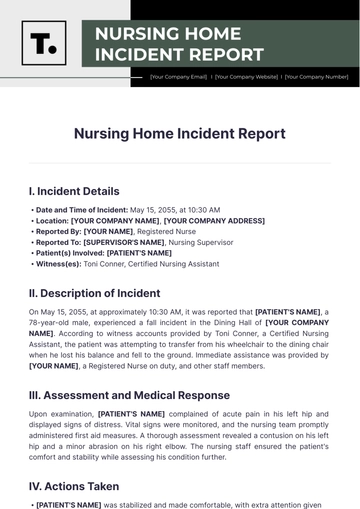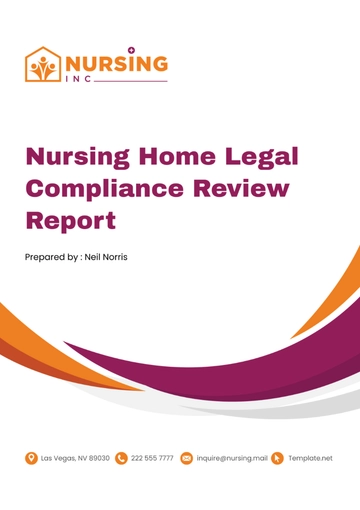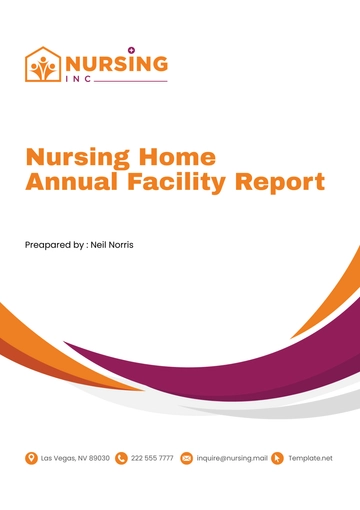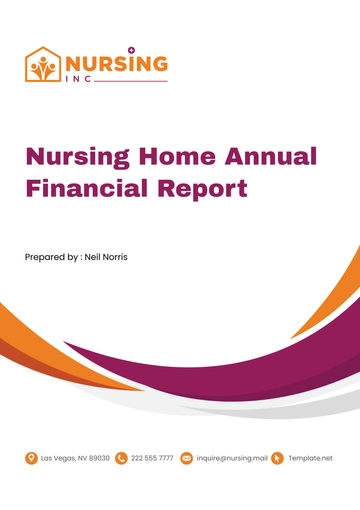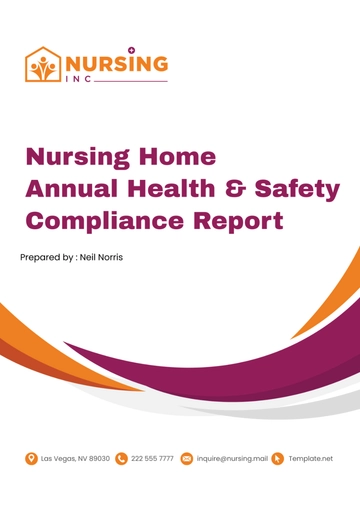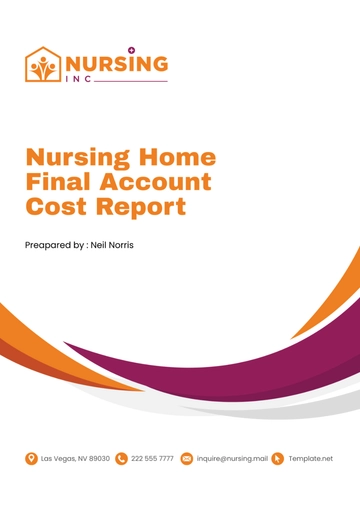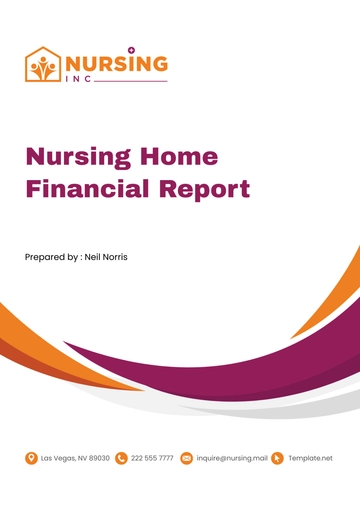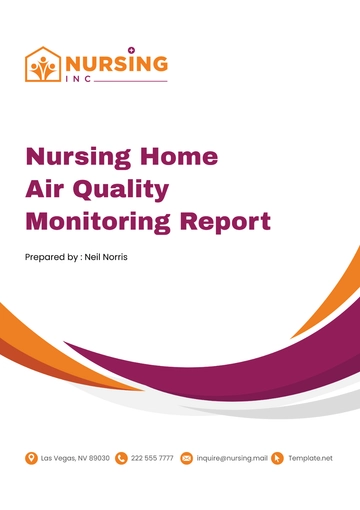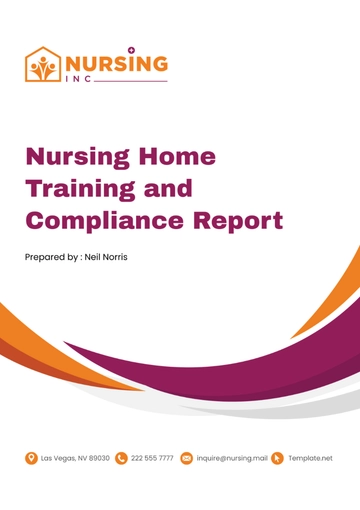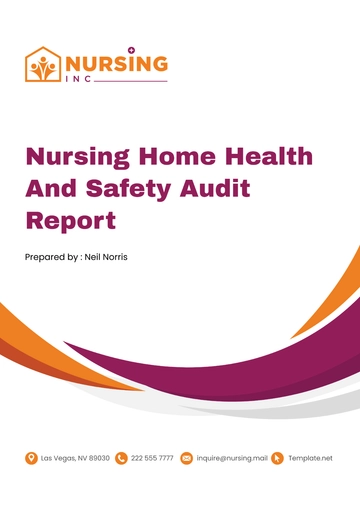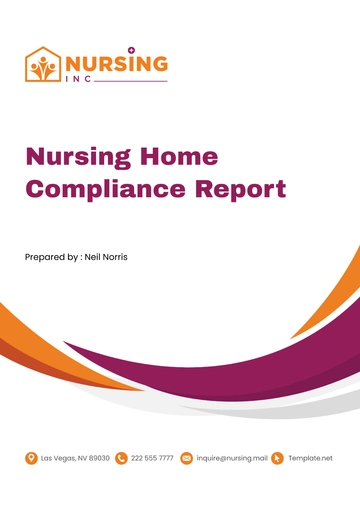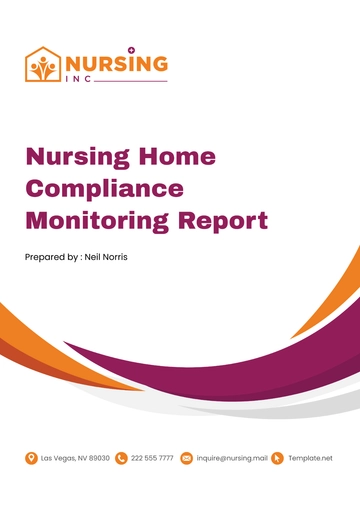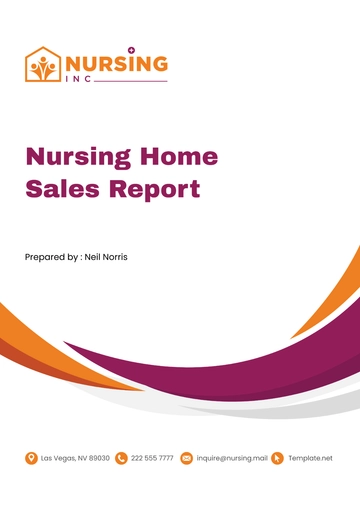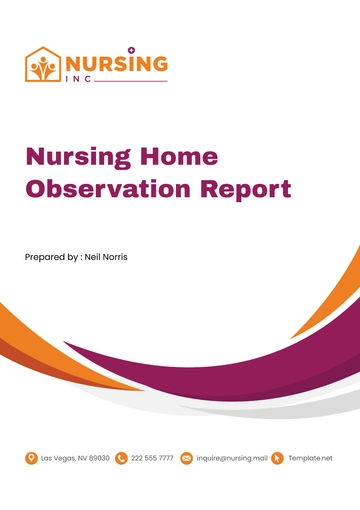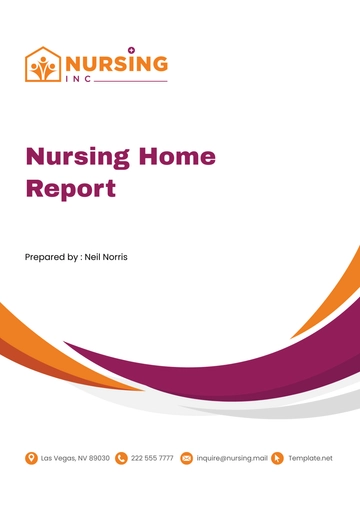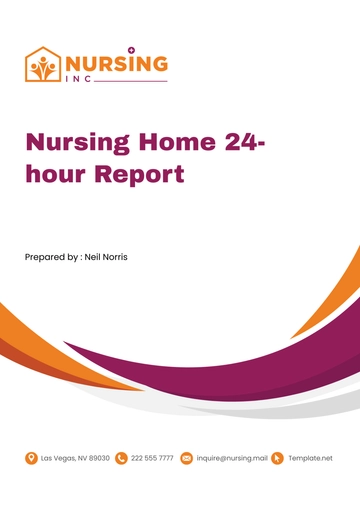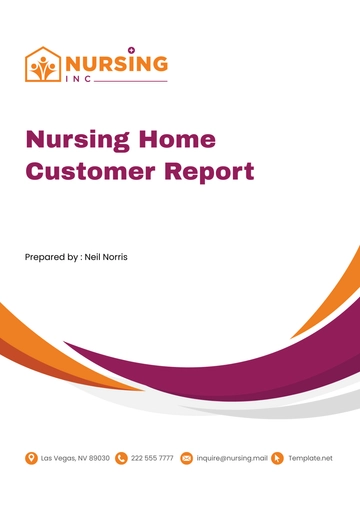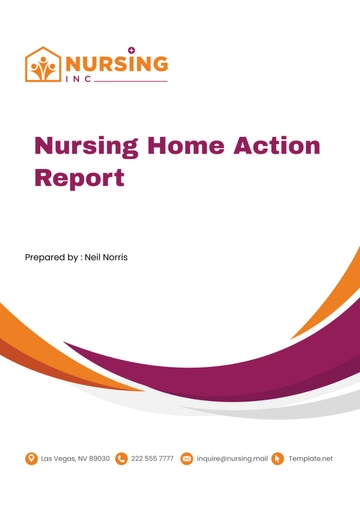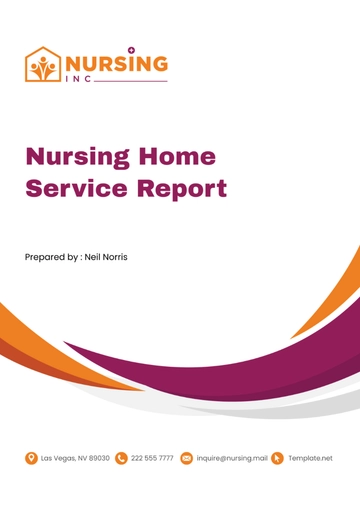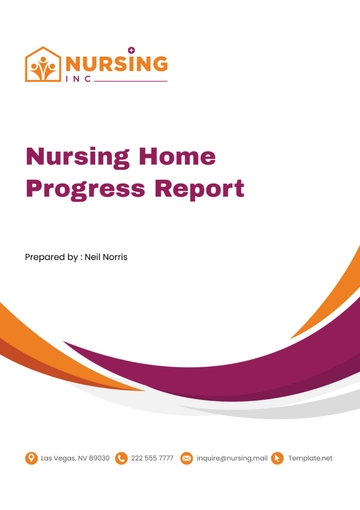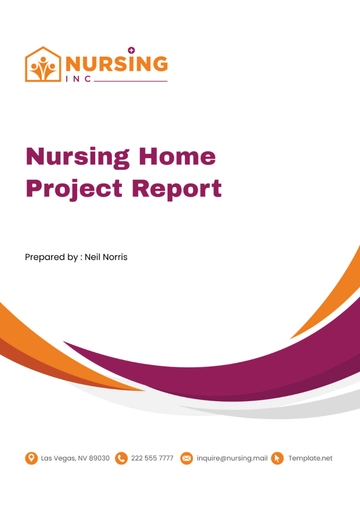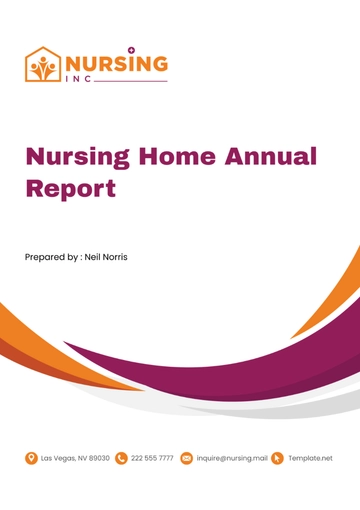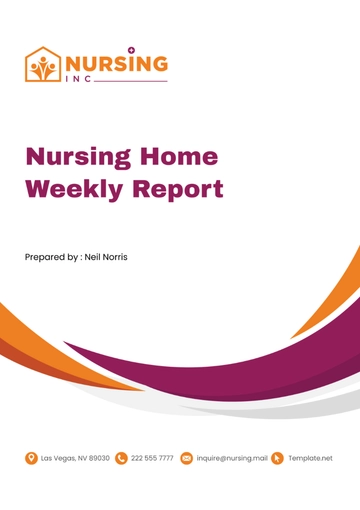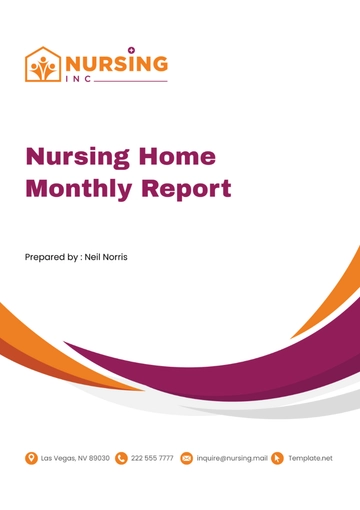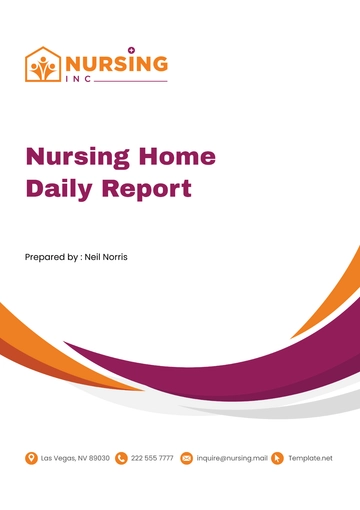Free Nursing Home Work Report
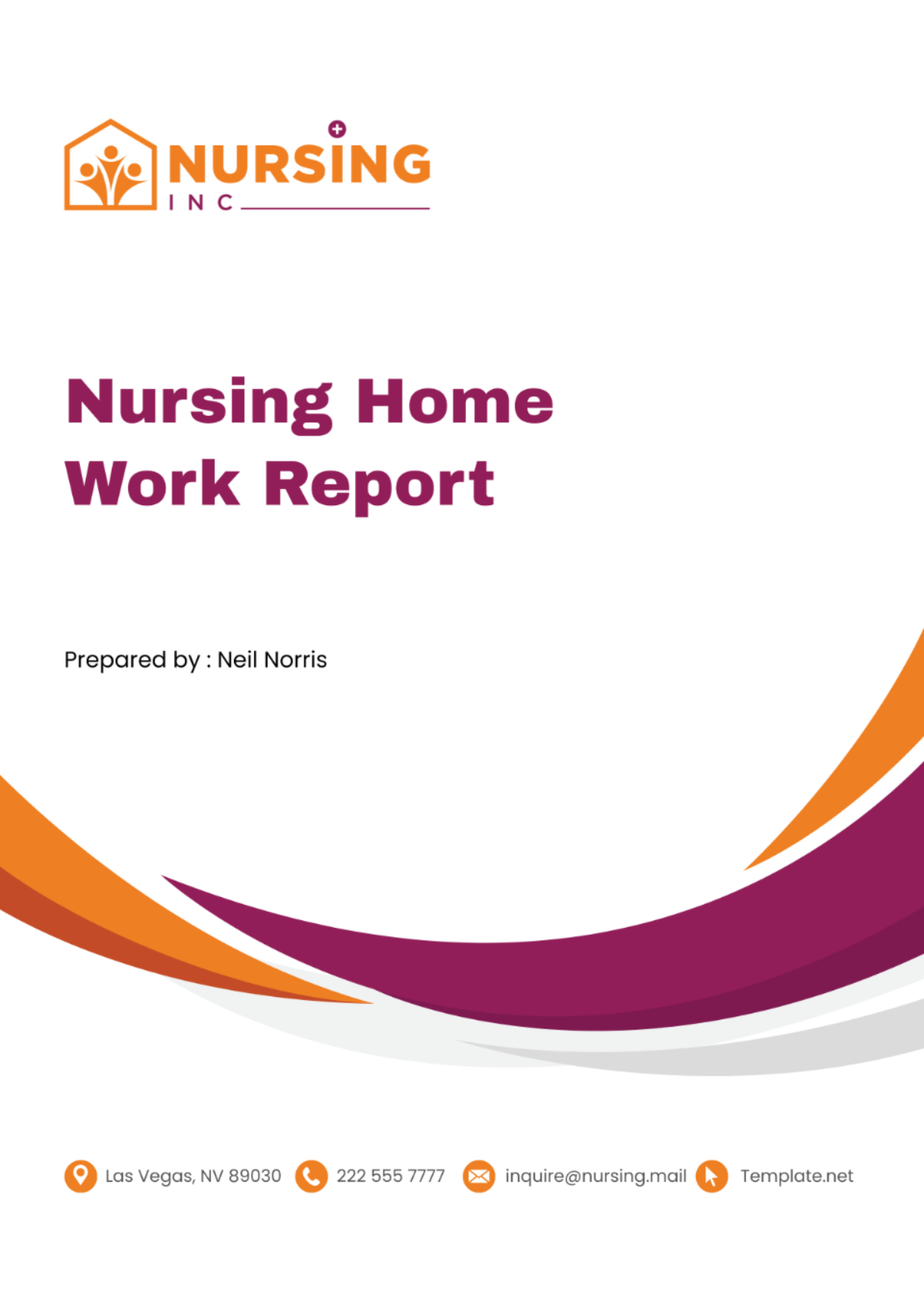
I. Introduction
In adherence to our commitment to providing high-quality care to our residents, this comprehensive Nursing Home Work Report outlines the activities, observations, and tasks performed by our dedicated staff at [Your Company Name] on April 2, 2024.
II. Patient Care Activities
Throughout the day, our nursing staff diligently attended to the needs of our residents, ensuring their comfort, safety, and well-being. Key patient care activities included:
Administering medications as prescribed, with strict adherence to medication schedules and dosage instructions.
Assisting residents with activities of daily living, including bathing, grooming, dressing, and toileting, while promoting independence and dignity.
Conducting regular assessments of vital signs and monitoring residents' health status for any signs of deterioration or changes.
Providing wound care and dressing changes for residents with skin breakdown or injuries, ensuring proper healing and prevention of infections.
Implementing mobility exercises and positioning techniques to prevent pressure ulcers and maintain residents' physical function.
Collaborating with the dietary team to ensure residents' nutritional needs are met, including assistance with feeding and monitoring dietary intake.
Facilitating therapeutic activities and exercises to promote cognitive stimulation and physical well-being, tailored to individual resident preferences and abilities.
Offering palliative care and symptom management for residents with advanced illness or nearing end-of-life, focusing on comfort and dignity.
Conducting regular checks on residents at risk of falls or wandering, implementing appropriate interventions to ensure their safety.
Providing support and education to residents and their families on disease management, medication adherence, and coping strategies.
III. Facility Maintenance
Maintenance tasks were carried out promptly to uphold a clean, safe, and welcoming environment for our residents. These tasks included:
Regular cleaning and disinfection of resident rooms, common areas, and high-touch surfaces to prevent the spread of infections.
Inspection and maintenance of equipment and assistive devices to ensure they are in proper working condition.
Monitoring and addressing environmental factors such as temperature, lighting, and ventilation to optimize resident comfort.
The table below provides a clear overview of the facility maintenance tasks completed on April 2, 2024, along with the responsible staff members.
Task Description | Staff Responsible |
|---|---|
Regular cleaning and disinfection | Cleaning Staff |
Inspection and maintenance of equipment and assistive devices | Maintenance Team |
Monitoring and addressing environmental factors | Facility Manager |
IV. Incident Reports
During the reporting period, the following incidents were documented and addressed:
A resident experienced a minor fall in the dining area but did not sustain any injuries. Staff provided immediate assistance and conducted a thorough assessment to prevent further incidents.
One resident exhibited signs of respiratory distress, prompting swift intervention by our nursing team. Oxygen therapy was administered, and the resident's condition stabilized following prompt medical attention.
V. Communication with Healthcare Professionals
Effective communication with healthcare professionals is essential for coordinated care. Today, our staff communicated with:
Dr. Smith, the attending physician, regarding changes in residents' health status and medication adjustments.
The physical therapy team to coordinate rehabilitation sessions for residents recovering from injuries or surgeries.
The pharmacy for medication refills and clarification of prescription orders.
The occupational therapy team to discuss residents' progress in activities of daily living and functional independence.
The speech-language pathology team to address residents' communication and swallowing difficulties, ensuring appropriate interventions and strategies.
The social work department to assess residents' psychosocial needs and coordinate support services, including discharge planning and community resources.
The registered dietitian to review residents' nutritional assessments and dietary plans, ensuring individualized dietary interventions for optimal health outcomes.
The infection control team to report any communicable diseases or outbreaks and implement preventive measures to safeguard resident health.
The hospice and palliative care team to coordinate end-of-life care for residents and provide support to residents and their families during this difficult time.
The radiology department to schedule diagnostic imaging tests for residents as recommended by their healthcare providers.
VI. Resident Observations
Throughout the day, our staff closely monitored residents and documented notable observations, including:
Changes in Mental Status:
Increased confusion and agitation in a resident with dementia, prompting additional support and reassurance from our care team.
Improved cognitive function and alertness in a resident following engagement in stimulating activities such as puzzles and reminiscence therapy.
Mobility and Functional Status:
Improved mobility and independence in a resident following successful physical therapy sessions, evidenced by increased ability to perform activities of daily living.
Decline in mobility in a resident with a history of falls, leading to implementation of fall prevention strategies and increased monitoring.
Nutritional Status:
Decreased appetite and unintended weight loss in a resident, necessitating collaboration with the dietary team to modify meal plans and encourage nutritional supplementation.
Enhanced appetite and enjoyment of meals in a resident following introduction of preferred foods and dining assistance.
Skin Integrity:
Development of a pressure ulcer on a resident's sacrum, prompting immediate initiation of wound care interventions and repositioning schedules.
Improvement in skin condition in a resident receiving regular moisturization and skin checks, demonstrating prevention of skin breakdown.
Emotional Well-being:
Signs of social withdrawal and loneliness in a resident, prompting increased socialization opportunities and companionship from staff and fellow residents.
Positive mood and engagement during recreational activities, indicating a sense of enjoyment and fulfillment among residents.
Pain Management:
Increased reports of pain in a resident with arthritis, leading to adjustments in pain medication regimen and implementation of non-pharmacological pain management techniques.
Decrease in pain intensity in a resident following physical therapy exercises and application of heat therapy, enhancing overall comfort and well-being.
VII. Conclusion
In conclusion, the dedicated efforts of our staff at [Your Company Name] contribute to the provision of exceptional care and support for our residents. By meticulously documenting our activities and observations, we ensure accountability, continuity of care, and continuous improvement in our services. We remain committed to upholding the highest standards of excellence in nursing home care. Additionally, our commitment to ongoing training and professional development ensures that our staff stays updated with the latest advancements in the field, guaranteeing optimal care for our residents. Through open communication channels and a culture of empathy, we strive to foster a nurturing environment where residents feel valued and supported every step of the way.
- 100% Customizable, free editor
- Access 1 Million+ Templates, photo’s & graphics
- Download or share as a template
- Click and replace photos, graphics, text, backgrounds
- Resize, crop, AI write & more
- Access advanced editor
Efficiently document work activities in nursing home settings with Template.net's Nursing Home Work Report Template. Editable in our AI Editor Tool, this customizable template provides a structured format for recording daily tasks, accomplishments, and challenges encountered during work shifts. Enhance communication, track productivity, and maintain records effortlessly with the use of our versatile template!
You may also like
- Sales Report
- Daily Report
- Project Report
- Business Report
- Weekly Report
- Incident Report
- Annual Report
- Report Layout
- Report Design
- Progress Report
- Marketing Report
- Company Report
- Monthly Report
- Audit Report
- Status Report
- School Report
- Reports Hr
- Management Report
- Project Status Report
- Handover Report
- Health And Safety Report
- Restaurant Report
- Construction Report
- Research Report
- Evaluation Report
- Investigation Report
- Employee Report
- Advertising Report
- Weekly Status Report
- Project Management Report
- Finance Report
- Service Report
- Technical Report
- Meeting Report
- Quarterly Report
- Inspection Report
- Medical Report
- Test Report
- Summary Report
- Inventory Report
- Valuation Report
- Operations Report
- Payroll Report
- Training Report
- Job Report
- Case Report
- Performance Report
- Board Report
- Internal Audit Report
- Student Report
- Monthly Management Report
- Small Business Report
- Accident Report
- Call Center Report
- Activity Report
- IT and Software Report
- Internship Report
- Visit Report
- Product Report
- Book Report
- Property Report
- Recruitment Report
- University Report
- Event Report
- SEO Report
- Conference Report
- Narrative Report
- Nursing Home Report
- Preschool Report
- Call Report
- Customer Report
- Employee Incident Report
- Accomplishment Report
- Social Media Report
- Work From Home Report
- Security Report
- Damage Report
- Quality Report
- Internal Report
- Nurse Report
- Real Estate Report
- Hotel Report
- Equipment Report
- Credit Report
- Field Report
- Non Profit Report
- Maintenance Report
- News Report
- Survey Report
- Executive Report
- Law Firm Report
- Advertising Agency Report
- Interior Design Report
- Travel Agency Report
- Stock Report
- Salon Report
- Bug Report
- Workplace Report
- Action Report
- Investor Report
- Cleaning Services Report
- Consulting Report
- Freelancer Report
- Site Visit Report
- Trip Report
- Classroom Observation Report
- Vehicle Report
- Final Report
- Software Report
